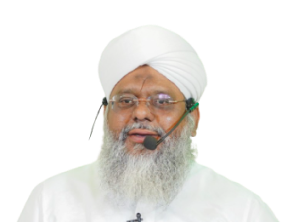
Dr. Mufti Syed Ziauddin Naqshbandi Mujaddidi Qadri
Shaykh Ul Fiqh, Jamia Nizamia; Founder - Director



Economic progress has enabled human beings to fly like birds, but they are yet to learn how to walk properly like human beings. With regard to following the rules of Islam and obeying the Shariah, Muslims are slipping back day by day. “Modern” (read libertine) culture has taken hold of their hearts. These are such times that articles of Islam and acts of worship are also being done as a custom and/or for the sake of fashion.
Hijab, by whatever name it is called, its very name creates an impression of dignity and grace in the hearts and minds of one and all. Even this is being followed only as custom. Hijab as such has ordered for both men and women, but there are certain differences in the rules for both sexes. The Hijab for men is from their navel to below their knees and that for women is their whole body. The latter may keep their face, their hands and their feet uncovered before the Mahram relatives.
Hijab as been ordained so that women don’t get embroiled in any tribulation, and that they shield themselves from the gaze of men. Thus, the more simple the Hijab is, the better it is. Fashionable and Hijab and colorful Hijab attract men. Thus, the women of the blessed era of the Holy Prophet (Sallallahu alaihi wa sallam) would wear black chadors. Then, fashionable Hijab with fancy designs did not exist at all.
Thus, it is mentioned in Tafseer Durre Manthoor under the following verse:
O Prophet! Say to your wives, your daughters and the women of believers that, (whilst going out,) they should draw their veils as coverings over them. It is more likely that this way they may be recognized (as pious, free women), and may not be hurt (considered by mistake as roving slave girls). And Allah is Most Forgiving, Ever-Merciful. Surah Ahzaab (33:59)
Translation: It is narrated on the authority of Hadhrat Umm Salama (May Allah be well pleased with her), she says: When the verse was revealed, the ladies of the Madinite Companions (Ansar) would step out from their houses at need as if crows were perched on their heads (i.e. their heads would be lowered) and they would wear black Hijab. (Ad Durr Al Manthoor, Surah Ahzaab-59)
This shows that the Hijab for women should be black in color. This is acting on the Sunnah of those blessed ladies as well. Also, when women step out of their houses, they should not be looking here, there and everywhere as it is against the tenets of modesty.
Only slave-girls would not cover their faces!
In ancient times when men and women could be made slaves, keeping their respective situations in mind, Islam gave separate rules for slaves and free folk respectively. Thus, with regard to Hijab, the free women had to cover their whole body and the slave-girls could keep their face uncovered. Since slaves had to follow the orders of their masters, some rules are different for them. One among them is this rule. Since the pre-Islamic times, it was the custom that slave-girls would not cover their faces. In those days, the hypocrites and other rogues would wait on the narrow streets at night and when women would step out of their houses for hygiene purposes (there was no sewerage system), they would tease those women whose faces were uncovered. They would desist from teasing those women who covered their faces. As mentioned in this Tradition related by Hadhrat Sa’adi (May Allah be well pleased with him) mentioned in Durre Manthoor in the exegesis of the aforementioned verse.
If we reflect in the light of the aforementioned Tradition, whatever happened with those who didn’t cover their faces happens today as well. The respect and reverence shown to those who cover their faces also continues to this day. Even today, as then, those who cover their faces are left alone by the criminal elements as well.
The correct method of wrapping the Jilbaab
In the aforementioned verse of the Holy Quran, women have been ordered to use Jilbaab (i.e. a dupatta in the South-Asian contexts). The question is how should the Jilbaab be worn? Hadhrat ‘Allama Ibn Sireen (May Allah shower His Mercy on him) put this question to Hadhrat ‘Ubaidah Salmani (May Allah shower His Mercy on her). She demonstrated this to him. First she placed it over her head in such a manner that all her hairs were covered by it. Then she wound it over eyebrows. Then, she covered her face with the other end….Hadhrat ‘Abdullah bin ‘Abbas (May Allah be well pleased with them) said: The Jilbaabi (i.e. dupatta) which a women wears on her head should cover her face and her bosom also with it. (Tafseer Ruh Al Ma’ani, Surah Ahzaab-59)
Thus, the method of our Pious Predecessors shows that the Dupatta which is worn on the head should be big enough to cover all the hair and the face and the bosom along with it. It shouldn’t be so small that it doesn’t cover the head itself properly. Nowadays, small dupattas are being used by one and all, which is simply against the tenets of Islam.
To summarize, the woman’s face is also included in Hijab. Hijab is to cover the body and not to display or highlight it. One can reap all the benefits of Hijab only when it is done as per Islamic precepts. May Allah grant men and women to lead their lives in pursuit of Allah’s and His Prophets’ (Sallallahu alaihi wa sallam) pleasure and approval. May Allah guide us all.